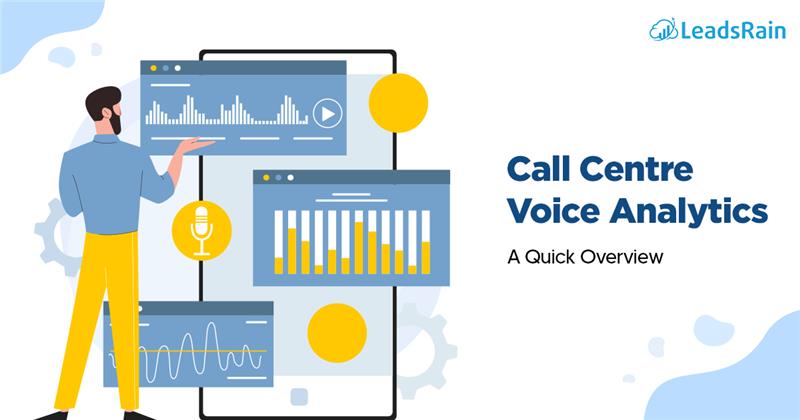Call centers handle thousands of customer interactions daily, making it impossible to manually track and analyze every conversation. Understanding customer emotions, identifying common pain points, and ensuring compliance require advanced solutions that go beyond traditional call monitoring.
Call center voice analytics is an AI-driven technology that processes spoken interactions, detects keywords, analyzes sentiment, and extracts insights to optimize business operations. Whether for improving sales, customer support, or regulatory compliance, this technology is becoming a game-changer.
In this article, we will explore how call center voice analytics works, why businesses need it, its benefits, and real-world use cases to understand its impact.
How Call Center Voice Analytics Works?
Call center voice analytics is an AI-powered tool that analyzes spoken interactions in real-time or post-call. It transcribes calls, detects keywords, and even picks up on emotions, sentiments, and behavioral cues to derive actionable insights.
It’s like having a data scientist for every call, helping businesses optimize conversations without listening to hours of recordings.
Call center voice analytics leverages artificial intelligence, natural language processing (NLP), and machine learning to analyze voice conversations. This technology can be applied in real-time during live calls or post-call for comprehensive reporting.
1. Speech-to-Text Transcription
Voice analytics systems convert spoken words into text using advanced speech recognition technology. This step is essential for extracting keywords, phrases, and sentiment patterns from conversations.
2. Keyword and Phrase Detection
AI-powered analytics tools recognize specific words and phrases relevant to customer concerns, sales opportunities, or compliance requirements. This helps businesses identify patterns in conversations that lead to successful outcomes or recurring issues.
3. Sentiment and Emotion Analysis
Sentiment analysis determines whether a customer interaction is positive, negative, or neutral. Tone, pitch, speech patterns, and word choices help AI models detect frustration, satisfaction, or hesitation, providing insights into customer experiences.
4. Call Categorization and Trend Analysis
Calls are automatically categorized based on topics such as complaints, inquiries, or sales opportunities. Trend analysis helps businesses identify recurring themes, allowing them to address common customer concerns and improve service strategies.
5. Real-Time Monitoring and Alerts
Real-time voice analytics provides supervisors and agents with instant feedback. Alerts notify managers of potential compliance risks, dissatisfied customers, or sales opportunities, enabling timely intervention.
What Are the Benefits of Call Center Voice Analytics?
Call center voice analytics helps businesses optimize operations, improve customer satisfaction, and enhance agent performance. With AI-driven insights, companies can proactively address customer concerns, boost sales, and ensure compliance.
- Enhances customer experience by identifying pain points and improving service quality
- Increases sales by identifying high-converting scripts and agent techniques
- Ensures regulatory compliance by detecting potential violations in real-time
- Improves agent training through performance tracking and feedback mechanisms
- Reduces customer churn by identifying dissatisfaction and resolving issues proactively
- Speeds up call resolution times by automating call categorization and response suggestions
- Provides real-time insights that help managers make data-driven decisions
- Streamlines quality assurance by analyzing every call instead of random samples
How Call Center Voice Analytics is Transforming the Industry?
The integration of predictive analytics is helping companies anticipate customer needs and prevent issues before they arise. Real-time coaching tools are equipping agents with actionable feedback during calls, leading to improved performance and customer satisfaction. Automation is reducing manual call reviews, allowing managers to focus on high-impact training and decision-making.
The ability to analyze every conversation is enabling businesses to shift from reactive customer service to proactive engagement. This transformation is setting a new standard for call centers, making them more efficient, data-driven, and customer-focused.
1. Insurance and Healthcare
Insurance providers and healthcare call centers must adhere to strict regulatory guidelines while ensuring a seamless customer experience. Companies are using voice analytics to monitor conversations for compliance adherence, reducing legal risks and ensuring agents follow prescribed scripts. This technology helps identify policyholder concerns, improving retention rates and policy sales.
After implementing voice analytics, insurers have reported fewer compliance breaches, improved call handling efficiency, and a better understanding of customer sentiment. Healthcare providers are leveraging analytics to detect patient concerns early, leading to enhanced patient engagement and satisfaction.
2. Real Estate and Mortgage Sales
In real estate and mortgage sales, timely and personalized communication is essential for converting leads into clients. Companies are using voice analytics to detect high-intent buyers based on keywords and emotional cues. Identifying customer objections allows businesses to refine their sales approach and close deals faster.
Voice analytics has helped mortgage brokers optimize sales scripts, leading to higher conversion rates. Real estate firms have seen a reduction in follow-up call times as agents now have insights into a lead’s intent before re-engaging them.
3. Debt Collection and Financial Services
Debt collection agencies must balance efficiency with compliance and customer sensitivity. Companies are using voice analytics to assess customer emotions, ensuring that agents take the right approach during calls. Identifying at-risk customers early helps businesses personalize repayment plans and avoid escalations.
After deploying voice analytics, financial service providers have reduced disputes, improved agent performance, and increased debt recovery rates. The ability to monitor tone and sentiment has led to more successful negotiations and better customer outcomes.
4. E-commerce and Retail Customer Support
E-commerce businesses handle high volumes of customer inquiries, ranging from order tracking to product complaints. Voice analytics is being used to categorize customer concerns and prioritize urgent cases. This allows businesses to streamline support, reduce resolution times, and enhance customer satisfaction.
Retail companies have reported lower call abandonment rates and improved first-call resolution. Insights from voice analytics help brands refine customer service strategies, leading to a more personalized and efficient support experience.
Summing it up
Call center voice analytics is no longer an optional tool; it is a necessity for businesses looking to improve customer experience, sales, and compliance. AI-driven insights help companies make smarter decisions while enabling agents to communicate more effectively. As competition grows, businesses that leverage voice analytics gain a strategic advantage in delivering superior service and maximizing revenue opportunities.Organizations that implement voice analytics see measurable improvements in operational efficiency, customer satisfaction, and agent performance. To explore how voice analytics can benefit your business, reach out to support@leadsrain.com for more information.




